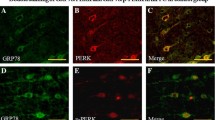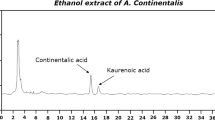Abstract
Post-traumatic stress disorder (PTSD) is a common psychiatric disease following exposure to a severe traumatic event or physiological stress, yet the precise mechanisms underlying PTSD remains largely to be determined. Using an animal model of PTSD induced by a single prolonged stress (SPS), we assessed the role of hippocampal nicotinamide adenosine dinucleotide phosphate (NADPH) oxidase 2 (NOX2) and parvalbumin (PV) interneurons in the development of PTSD symptoms. In the present study, behavioral tests were performed by the open field (day 13 after SPS) and fear conditioning tests (days 13 and 14 after SPS). For the interventional study, rats were chronically treated with a NADPH oxidase inhibitor apocynin either by early or delayed administration. The levels of tumor necrosis factor-alpha, interleukin (IL)-1β, IL-6, IL-10, malondialdehyde, superoxide dismutase, NOX2, 4-hydroxynonenal, and PV in the hippocampus were measured at the indicated time points. In the present study, we showed that SPS rats displayed anxiety-like and enhanced fear learning behavior, which was accompanied by the increased expressions of malondialdehyde, IL-6, NOX2, 4-hydroxynonenal, and decreased PV expression. Notably, early but not delayed treatment with apocynin reversed all these abnormalities after SPS. In conclusion, our results provided evidence that NOX2 activation in the hippocampus, at least in part, contributes to oxidative stress and neuroinflammation, which further results in PV interneuron loss and consequent PTSD symptoms in a rat model of PTSD induced by SPS.







Similar content being viewed by others
References
Qiu ZK, Zhang LM, Zhao N, Chen HX, Zhang YZ, Liu YQ, Mi TY, Zhou WW et al (2013) Repeated administration of AC-5216, a ligand for the 18 kDa translocator protein, improves behavioral deficits in a mouse model of post-traumatic stress disorder. Prog Neuropsychopharmacol Biol Psychiatry 45:40–46. doi:10.1016/j.pnpbp.2013.04.010
Gamache K, Pitman RK, Nader K (2012) Preclinical evaluation of reconsolidation blockade by clonidine as a potential novel treatment for posttraumatic stress disorder. Neuropsychopharmacology 37(13):2789–2796. doi:10.1038/npp.2012.145
Ji MH, Jia M, Zhang MQ, Liu WX, Xie ZC, Wang ZY, Yang JJ (2014) Dexmedetomidine alleviates anxiety-like behaviors and cognitive impairments in a rat model of post-traumatic stress disorder. Prog Neuropsychopharmacol Biol Psychiatry 54:284–288. doi:10.1016/j.pnpbp.2014.06.013
Johansen JP, Cain CK, Ostroff LE, LeDoux JE (2011) Molecular mechanisms of fear learning and memory. Cell 147(3):509–524. doi:10.1016/j.cell.2011.10.009
Parsons RG, Ressler KJ (2013) Implications of memory modulation for post-traumatic stress and fear disorders. Nat Neurosci 16(2):146–153. doi:10.1038/nn.3296
Wilson CB, McLaughlin LD, Ebenezer PJ, Nair AR, Francis J (2014) Valproic acid effects in the hippocampus and prefrontal cortex in an animal model of post-traumatic stress disorder. Behav Brain Res 268:72–80. doi:10.1016/j.bbr.2014.03.029
Wilson CB, McLaughlin LD, Nair A, Ebenezer PJ, Dange R, Francis J (2013) Inflammation and oxidative stress are elevated in the brain, blood, and adrenal glands during the progression of post-traumatic stress disorder in a predator exposure animal model. PLoS One 8:e76146. doi:10.1371/journal.pone.0076146
Gola H, Engler H, Sommershof A, Adenauer H, Kolassa S, Schedlowski M, Groettrup M, Elbert T et al (2013) Posttraumatic stress disorder is associated with an enhanced spontaneous production of pro-inflammatory cytokines by peripheral blood mononuclear cells. BMC Psychiatry 13:40. doi:10.1186/1471-244X-13-40
Bulut M, Selek S, Bez Y, Karababa IF, Kaya MC, Gunes M, Emhan A, Aksoy N et al (2013) Reduced PON1 enzymatic activity and increased lipid hydroperoxide levels that point out oxidative stress in generalized anxiety disorder. J Affect Disord 150(3):829–833. doi:10.1016/j.jad.2013.03.011
Zhou Z, Zhang G, Li X, Liu X, Wang N, Qiu L, Liu W, Zuo Z et al (2015) Loss of phenotype of parvalbumin interneurons in rat prefrontal cortex is involved in antidepressant- and propsychotic-like behaviors following acute and repeated ketamine administration. Mol Neurobiol 51(2):808–819. doi:10.1007/s12035-014-8798-2
Del Pino I, García-Frigola C, Dehorter N, Brotons-Mas JR, Alvarez-Salvado E, Martínez de Lagrán M, Ciceri G, Gabaldón MV et al (2013) Erbb4 deletion from fast-spiking interneurons causes schizophrenia-like phenotypes. Neuron 79(6):1152–1168. doi:10.1016/j.neuron.2013.07.010
Wöhr M, Orduz D, Gregory P, Moreno H, Khan U, Vörckel KJ, Wolfer DP, Welzl H et al (2015) Lack of parvalbumin in mice leads to behavioral deficits relevant to all human autism core symptoms and related neural morphofunctional abnormalities. Translat Psychiatry 5:e525. doi:10.1038/tp.2015.19
Verret L, Mann EO, Hang GB, Barth AM, Cobos I, Ho K, Devidze N, Masliah E et al (2012) Inhibitory interneuron deficit links altered network activity and cognitive dysfunction in Alzheimer model. Cell 149(3):708–721. doi:10.1016/j.cell.2012.02.046
Yekhlef L, Breschi GL, Lagostena L, Russo G, Taverna S (2015) Selective activation of parvalbumin- or somatostatin-expressing interneurons triggers epileptic seizure like activity in mouse medial entorhinal cortex. J Neurophysiol 113(5):1616–1630. doi:10.1152/jn.00841.2014
Schiavone S, Sorce S, Dubois-Dauphin M, Jaquet V, Colaianna M, Zotti M, Cuomo V, Trabace L et al (2009) Involvement of NOX2 in the development of behavioral and pathologic alterations in isolated rats. Biol Psychiatry 66(4):384–392. doi:10.1016/j.biopsych.2009.04.033
Matsumoto Y, Morinobu S, Yamamoto S, Matsumoto T, Takei S, Fujita Y, Yamawaki S (2013) Vorinostat ameliorates impaired fear extinction possibly via the hippocampal NMDA-CaMKII pathway in an animal model of posttraumatic stress disorder. Psychopharmacology (Berl) 229(1):51–62. doi:10.1007/s00213-013-3078-9
Keller SM, Schreiber WB, Staib JM, Knox D (2015) Sex differences in the single prolonged stress model. Behav Brain Res 286:29–32. doi:10.1016/j.bbr.2015.02.034
Laukova M, Alaluf LG, Serova LI, Arango V, Sabban EL (2014) Early intervention with intranasal NPY prevents single prolonged stress-triggered impairments in hypothalamus and ventral hippocampus in male rats. Endocrinology 155(10):3920–3933. doi:10.1210/en.2014-1192
Hernandes MS, D'Avila JC, Trevelin SC, Reis PA, Kinjo ER, Lopes LR, Castro-Faria-Neto HC, Cunha FQ et al (2014) The role of Nox2-derived ROS in the development of cognitive impairment after sepsis. J Neuroinflammation 11:36. doi:10.1186/1742-2094-11-36
Wu J, Dong L, Zhang M, Jia M, Zhang G, Qiu L, Ji M, Yang J (2013) Class I histone deacetylase inhibitor valproic acid reverses cognitive deficits in a mouse model of septic encephalopathy. Neurochem Res 38(11):2440–2449. doi:10.1007/s11064-013-1159-0
Ji M, Dong L, Jia M, Liu W, Zhang M, Ju L, Yang J, Xie Z et al (2014) Epigenetic enhancement of brain-derived neurotrophic factor signaling pathway improves cognitive impairments induced by isoflurane exposure in aged rats. Mol Neurobiol 50(3):937–944. doi:10.1007/s12035-014-8659-z
Ozdemir O, Selvi Y, Ozkol H, Tuluce Y, Besiroglu L, Aydin A (2012) Comparison of superoxide dismutase, glutathione peroxidase and adenosine deaminase activities between respiratory and nocturnal subtypes of patients with panic disorder. Neuropsychobiology 66(4):244–251. doi:10.1159/000341880
Yang JJ, Wang N, Yang C, Shi JY, Yu HY, Hashimoto K (2015) Serum interleukin-6 is a predictive biomarker for ketamine’s antidepressant effect in treatment-resistant patients with major depression. Biol Psychiatry 77(3):e19–e20. doi:10.1016/j.biopsych.2014.06.021
Miller MW, Sadeh N (2014) Traumatic stress, oxidative stress and post-traumatic stress disorder: neurodegeneration and the accelerated-aging hypothesis. Mol Psychiatry 19(11):1156–1162. doi:10.1038/mp.2014.111
Kann O, Papageorgiou IE, Draguhn A (2014) Highly energized inhibitory interneurons are a central element for information processing in cortical networks. J Cereb Blood Flow Metab 34:1270–1282. doi:10.1038/jcbfm.2014.104
Neske GT, Patrick SL, Connors BW (2015) Contributions of diverse excitatory and inhibitory neurons to recurrent network activity in cerebral cortex. J Neurosci 35(8):1089–1105. doi:10.1523/JNEUROSCI.2279-14
Brenhouse HC, Andersen SL (2011) Nonsteroidal anti-inflammatory treatment prevents delayed effects of early life stress in rats. Biol Psychiatry 70(5):434–440. doi:10.1016/j.biopsych.2011.05.006
Seo JS, Park JY, Choi J, Kim TK, Shin JH, Lee JK, Han PL (2012) NADPH oxidase mediates depressive behavior induced by chronic stress in mice. J Neurosci 32(28):9690–9699. doi:10.1523/JNEUROSCI.0794-12
Dugan LL, Ali SS, Shekhtman G, Roberts AJ, Lucero J, Quick KL, Behrens MM (2009) IL-6 mediated degeneration of forebrain GABAergic interneurons and cognitive impairment in aged mice through activation of neuronal NADPH oxidase. PLoS One 4:e5518. doi:10.1371/journal.pone.0005518
Behrens MM, Ali SS, Dugan LL (2008) Interleukin-6 mediates the increase in NADPH-oxidase in the ketamine model of schizophrenia. J Neurosci 28(51):13957–13966. doi:10.1523/JNEUROSCI.4457-08
Keding TJ, Herringa RJ (2015) Abnormal structure of fear circuitry in pediatric post-traumatic stress disorder. Neuropsychopharmacology 40(3):537–545. doi:10.1038/npp.2014.239
Ji LL, Tong L, Xu BK, Fu CH, Shu W, Peng JB, Wang ZY (2014) Intra-hippocampal administration of ZIP alleviates depressive and anxiety-like responses in an animal model of posttraumatic stress disorder. Behav Brain Funct 10:28. doi:10.1186/1744-9081-10-28
Acknowledgments
This work was supported by the National Natural Science Foundation of China (No 81400876) and Science Foundation of Jinling Hospital (No 2015012).
Author information
Authors and Affiliations
Corresponding authors
Ethics declarations
Conflict of Interest
The authors declare that they have no competing interests.
Ethical Approval
The experimental protocol was approved by the Ethics Committee of Jinling Hospital, Nanjing University, and the study was conducted in accordance with the Guideline for the Care and Use of Laboratory Animals from the National Institutes of Health, USA.
Rights and permissions
About this article
Cite this article
Liu, Ff., Yang, Ld., Sun, Xr. et al. NOX2 Mediated-Parvalbumin Interneuron Loss Might Contribute to Anxiety-Like and Enhanced Fear Learning Behavior in a Rat Model of Post-Traumatic Stress Disorder. Mol Neurobiol 53, 6680–6689 (2016). https://doi.org/10.1007/s12035-015-9571-x
Received:
Accepted:
Published:
Issue Date:
DOI: https://doi.org/10.1007/s12035-015-9571-x




